8/15/1914 - Two and a half miles south of the Wisconsin village of Spring Green, as if providing evidence once more that all of life is just a dance on thin ice that could give way at any moment, the 91-year-long journey of genius Frank Lloyd Wright is unexpectedly and dreadfully altered when murder comes to the beautiful grounds of the architect's Prairie School designed home, Taliesin.
Taliesin
Born to talented parents, William Clay Wright (a musician, orator, preacher, and lawyer) and Anna Lloyd Jones (a Wisconsin school teacher), on June 8, 1867, in the town of Richard Center, Wisconsin, Frank Lloyd Wright is destined to be an architect from the moment he is conceived (his mother states her first born will grow up to build beautiful buildings). Playing with building blocks as a child (supplied by his mother), Wright gets home schooling in the arts from both parents, attends Madison High School, attends classes at the University of Wisconsin-Madison, before moving to Chicago in 1887 to begin building beautiful buildings. Arriving in a Windy City in desperate need of an overhaul following its burning in 1871, Wright continues his education in constructing structures by finding apprentice work with the #1 architectural firm in town, Adler & Sullivan. Taken under the wing of Louis Henry Sullivan, Wright is soon constantly at work on the firm's public projects, and on building private homes in the Oak Park region of Chicago. After arguments with Sullivan over Wright taking home building commissions outside of work, the young designer opens his own architectural firm in 1893 (the two men will not speak to each other for 12 years). Successful at designing homes and on other building projects, a smitten Wright will marry socialite Catherine "Kitty" Tobin in June of 1889 and begins growing a family that will eventually be made up of six children, four ... Frank Lloyd, Jr., John Lloyd, Catherine, David Samuel, Frances, and Robert Llwellyn. Course seemingly set for the rest of his life, Wright falls in love with the wife of a client, Mary "Mamah" Bouton Borthwick Cheney, and everything changes.
Wright's Parents
 Sullivan
Sullivan
 Mamah
Mamah
Born in Boone, Iowa in 1869, Mamah Borthwick is immediately an intoxicating presence to Wright when he meets her in 1903. What will one day be described as a modern feminist, Mamah is educated at the University of Michigan and gains BA and MA degrees from the institution, marries an electrical engineer, for a time serves as the Port Huron librarian, and is the mother of two young children (and through her translations of Ellen Key, she will bring the Swedish feminist's ideas to an American audience). Identifying each other as soul mates and intellectual equals, the pair are a scandal to Oak Park and flee to Europe in 1909, leaving their families behind to pursue a bohemian life style well away from prying eyes. But Wright's business is back in Chicago and the two eventually return to the states (Mamah is granted a divorce from Cheney, but Wright's wife refuses, believing that sooner or later the architect will come to his senses and return to her), with Wright deciding that to escape the finger pointing and whispers of scandal about the couple, he will build his love an epic home out in the country where the two can live out their lives in peace. He calls the structure, Taliesin.
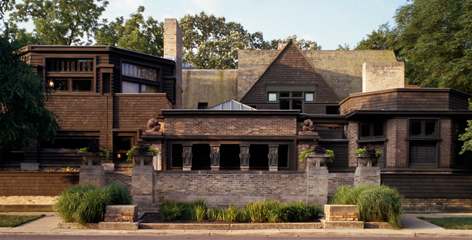 Wright's Home
Wright's Home
The Cheney House
Land he use to romp on as a child during vacations to visit Wisconsin family, purchased under his mother's name to keep the locals from getting agitated over "living in sin" with his lover, Wright pays homage to his Welsh roots when he names the abode Taliesin ... meaning "shining brow" or "radiant brow." Located on a limestone ridge overlooking a beautiful valley of Wisconsin farmland (the property contains 31.5 acres of land), designed using the tenets of his Prairie School style of architecture (horizontal lines, flat roofs with overhanging eaves, windows grouped in horizontal bands, extreme discipline in the use of ornamentation, and integration of the house with the surrounding landscape), the home Wright builds for Mamah consists of three sections ... two broad portions on either end of a narrow connecting loggia (a covered exterior corridor with walls open to the elements). One of the broad is made up of Wright's studio, workroom, and rooms for craftsmen, while the other is used to house Wright, Mamah, and any family members that might be visiting. Finished, the house contains almost 12,000 square feet of enclosed space. Wright and Mamah move in to the structure during the winter of 1911 and begin what they believe will be a long and happy artistic life in the country ... a life which will only last until 1914.
 Taliesin
Taliesin
On the hot dry summer Saturday of August 15, 1914, with Wright away in Chicago working on his latest project, the Midway Gardens of the city's Hyde Park, there are eleven individuals at Taliesin ... Mamah, Mamah's two children, John (12) and Martha (8), six workmen made up of 66-year-old handyman, Tom Brunker, 35-year-old carpenter, William "Billy" Weston, and his 13-year-old son, Ernest, 30-year-old architectural draftsman, Emile Brodelle, 20-year-old draftsman Herbert Fritz, 45-year-old Swedish gardener, David Lindblom, and two 30-year-old house servants from Barbados recommended to Wright by the prosperous Chicago caterer, John Vogelsang, Jr., the Carltons, Julian (a butler and handyman) and Gertrude (the resident cook) who are due to depart from Wright's employment later in the day (whether the pair give their notice or are fired by Mamah, the cause of their leaving will never be fully known, but there are intimations of mental illness as Julian spends many nights staring out a window while clutching a butcher knife, and racial animosity in which Julian's ire is continually raised by the jobs he is given and his interactions with the other Taliesin residents, including an incident over the saddling of Brodelle's horse in which he calls the Barbados butler "a black son of a bitch." Everyone moving through their normal daily routines (Martha is awaiting a visit from a local playmate named Edna Kritz with the pair planning to play together in a nearby tree with their dolls), the day takes it's tragic turn when the Taliesin residents break for lunch ... a meal they eat in two different locations, the workmen dine in the far western room of the residential wing of the home (with only one door leading outside) featuring a southwest wall of three low windows fronting a walled in garden and steep hill leading precipitously down to one of the property's many creeks, while Mamah and her two children are seated in a screened terrace table just off the family dining room where they can eat among cooling breezes and views of the Helena Valley and the Wisconsin River. The two groups are separated by about eighty feet of Taliesin.
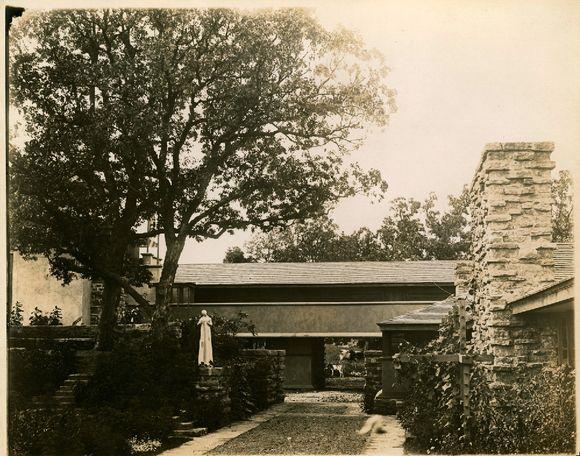 Taliesin
Taliesin
Snapped since being called a "black son of a bitch," with lunch ready for serving, Julian Carlton, unbeknownst to his wife, puts his murderous plans into effect ... dressed in his clean white service jacket the butler serves Mamah and her children soup, then will the family is spooning Mrs. Carlton's concoction down, pulls a shingling hatchet from behind his back and hacks it into the mistress of Taliesin's head (a blow so violent it almost cleaves Mamah's head in two), kills John with a heavy blow to his forehead, then chases down a fleeing, screaming Martha in the courtyard, and hammers away at her head with the hatchet (realizing her husband is responsible for the carnage taking place at Taliesin, Gertrude puts on her best hat, scrambles out a window, and makes her way down the hill to the road leading to the community of Spring Green). Phase One of the killings complete, the mad butler then turns his attention on to the workmen. Somehow keeping calm despite violently assaulting three people, Julian serves the workmen their soup, then leaves through the room's door to the outside. There, he bolts the door, pours the gasoline he has procured that morning under the guise of cleaning up a soiled rug under the door, ignites his pipe, and then flicks the lit match into the puddle of inflammable liquid at his feet. Whoosh, the room and men inside are suddenly on fire. Picking up his hatchet again, Julian waits outside to butcher anyone fortunate enough to escape the holocaust Carlton has created.
Martha And John Flank Their Cousin
 Murder Weapon
Murder Weapon
The room suddenly an inferno of fire and smoke, Fritz reacts instantly, throwing his burning body against one of the low windows. Shattering glass as he falls on the rocks below the home, breaks his arm, and rolls down the steep incline of the hill ... screaming. Alerted that his plans might go awry if the windows are used as escape exits, Julian leaves his position at the door and runs over to where the windows are located in his murder room ... and greets Brodelle just as he is coming out from the broken glass. Clothes on fire and screaming, Carlton ends the draftsman's life with a brain deep hatchet blow over the man's left ear (below, Fritz watches the murder, then when Julian is out of sight, slowly begins climbing back up the hill). Returning to his original position, Carlton and his hatchet are waiting as the burning men in the dining room finally burst through the door. No escape outside, Weston is hit twice in the head, but with the back of the weapon, and he falls senseless in the courtyard. Badly burnt, Brunker takes a glancing head blow and staggers away. The next victim targeted is young Weston. He is hit in the head by the hatchet and staggers away to collapse in the garden's ornamental fountain. Then Carlton comes at Lindblom and the gardener goes down from yet another violent hatchet blow to the head. Not quite done creating carnage, the mad butler chases down Brunker and kills him with yet another brain blow. Attacks over, Carlton grabs the balance of the gasoline he has procured for the killings, pours it on the bodies of Mamah, John, and Martha (she is still barely alive!), lights them on fire, and then vanishes just as Fritz makes back up the hill and collapses.
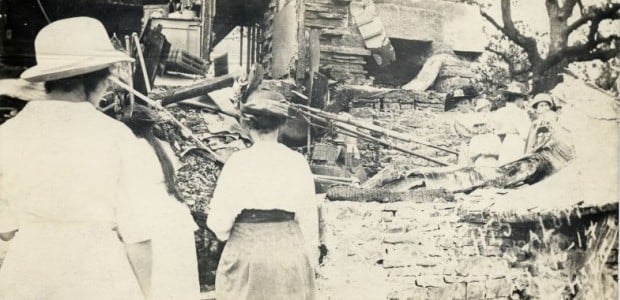 Ruins
Ruins
The first of the victims to come to his senses is Weston who chokes down the horror he has at finding his son's butchered body, and seeks help after rousing Lindblom (the gardener will live until Tuesday, 8/18). Battered and burnt, the two men shamble through a series of cornfields to reach the nearby (a half a mile away) Rieder Farm where a phone is located. Request for help phoned out, the men then return to Taliesin and Weston begins hosing down the fires burning at Taliesin (he will be credited with saving the work section of the home, the rest of Taliesin is gone in less than three hours). The community responding (eventually around 700 people will gather at the home), farmhands drawn to the smoke begin arriving and help fight the flames, move the bodies across the valley to Tan-y-Deri (the home of Frank Lloyd Wright's sister), and search for the missing killer. At about 5:30 in the earlier evening, Carlton is found semi-conscious, hiding in an asbestos-lined boiler, moaning in pain and muttering "acid" from having taken a dose of hydrochloric acid. Placed in custody by County Sheriff John Williams, after dodging several groups of vigilantes, Julian will be jailed in Dodgeville, the county seat, to await trial. But there will be no court reckoning for Carlton. Throat scarred almost shut by his suicidal drink, the killer butler will never discuss his reasons for the murders and slowly starves to death in his cell (he weighs around 90 pounds at the time of his death), perishing at 1:00 in the afternoon of October 7, 1914 (his body is given to the University of Wisconsin, which uses the corpse to teach three different groups of students anatomy, then his remains are cremated and disposed of at a number of different sites ... gone!). Dry for weeks, as if Heaven is crying over what has happened below, in the late evening it begins to rain.
 News
News
Ruins
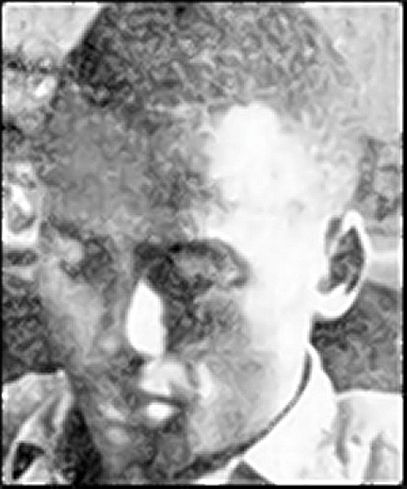 Carlton
Carlton
Advised that Taliesin is on fire, the 47-year-old Wright takes a train back to Wisconsin (also on the train is Mr. Cheney, who will bring his children's bodies back to Oak Park for burial) and tries to pick up the pieces of his life. Unwilling to continually mourn the loss of his love, he personally buries Mamah at an unmarked spot on the Taliesin property in a coffin filled with flowers the architect personally picks (zinnias, nasturtriums, and dahlias Mamah had planted herself). Devastated by what has taken place, Wright breaks out in boils, takes to sleeping on a cot in the back of his workshop, pounds away on the keys of a broken piano, paces endlessly about the ruins of his home, and rides his horse to various ridge lookouts on his property where he can stare down at locations that once held his dreams. Eventually, to survive, he throws himself into new work, which will include rebuilding Taliesin two more times (it will burn down again in April of 1925) ... beyond Taliesin, the architect will never build another house in the Prairie School style. Though he professes that his love for Mamah was so deep that he can't live remembering her, memories of Mamah will be with Wright for the rest of his life, and she will become an unspoken of influence on all the achievements he creates in the second half of his life (he also finds the time to marry twice more) ... grand achievements like establishing the Imperial Hotel in Tokyo, Japan, Taliesin Fellowship for architectural students, Fallingwater (a home that is built on a 30-foot waterfall in Pennsylvania), building a winter home and studio in Scottsdale, Arizona called Taliesin West, the 19-story Price Tower in Oklahoma, the Johnson Wax Headquarters in Racine, Wisconsin, Monona Terrace, Florida Southern College (featuring 12 Wright designed buildings), and New York City's Solomon R. Guggenheim Museum. Considered a genius and America's most famous architect, Wright passes away on April 4, 1959 after undergoing stomach surgery in Phoenix, Arizona. He is 91 years old at the time of his death.
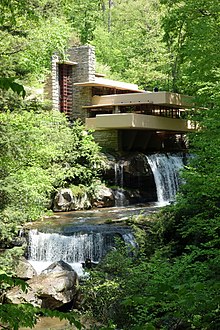
 The Guggenheim
The Guggenheim
Wright
No comments:
Post a Comment